Chronology and Petrogenesis of the Yangjiayu Complex from Eastern China: Evidence from Zircon U–Pb Dating, Hf Isotopes, and Geochemical Characteristics
Abstract
1. Introduction
Regional Geology
2. Geological Characteristics of the Yangjiayu Area
3. Samples and Analytical Methods
3.1. Petrographic Characteristics of Samples
3.2. Analytical Methods
3.2.1. CL Method
3.2.2. Zircon LA-ICP-MS U–Pb Dating
3.2.3. Zircon Lu–Hf Isotopic Analysis
3.2.4. Geochemical Analysis of Intrusion
4. Results
4.1. U–Pb Geochronology
4.2. Rock Geochemical Characteristics
4.2.1. Major Elements
4.2.2. Trace and Rare Earth Elements
4.3. Zircon Hf Isotopic Characteristics
5. Discussion
5.1. Petrogenetic Age of the Yangjiayu Pluton
5.2. Petrogenesis of Yangjiayu Pluton
5.3. Tectonic Setting of Rock Formation
5.4. Alteration-Mineralization Characteristics and Metallogenic Potential of the Pluton
6. Conclusions
- The Yangjiayu pluton consists of rhyolite porphyry and monzodiorite, with emplacement ages of 121.2 ± 0.6 Ma and 122.5 ± 0.7 Ma, respectively.
- Both the Yangjiayu monzodiorite and rhyolite porphyry are interpreted to have originated from partial melting of the Archean lower crust of the North China Craton. The monzodiorite preserves more source characteristics, whereas the rhyolite porphyry experienced extensive amphibole fractional crystallization during its evolution and was likely contaminated by the middle to upper crust.
- The Yangjiayu monzodiorite and rhyolite porphyry formed within the context of late Mesozoic lithospheric thinning and intra-continental extension in eastern North China.
- Cu, Pb, and Zn mineralization within the Yangjiayu monzodiorite is attributed to exsolved magmatic fluids. Approximately 120 Ma dioritic magmatism in the Jiaolai Basin exhibits the potential to host lead-zinc mineralization.
Author Contributions
Funding
Data Availability Statement
Conflicts of Interest
References
- Liu, J.H.; Li, Y.S.; Xu, W.N.; Ding, Z.J. The formation and geodynamic evolution of the Paleoproterozoic Jiao-Liao-Ji tectonic belt, North China craton. Acta Geol. Sin. 2025, 99, 23–43. [Google Scholar]
- Liu, J.L.; Ji, L.; Ni, J.L.; Chen, X.Y. Dynamics of the Early Cretaceous lithospheric thinning and destruction of the North China craton as the consequence of Paleo-Pacific type active continental margin. Acta Geol. Sin. 2022, 96, 3360–3380. [Google Scholar]
- Zhu, R.; Xu, Y. The subduction of the west Pacific plate and the destruction of the North China Craton. Sci. China Earth Sci. 2019, 62, 1340–1350. [Google Scholar] [CrossRef]
- Zhai, M.G. Tectonic evolution of the North China Craton. J. Geomech. 2019, 25, 722–745. [Google Scholar]
- Chang, Z.G.; Dong, G.C.; Scott, J.M. Early Cretaceous basalts record the modification of the North China Craton lithospheric mantle: Implications for lithospheric thinning. Int. Geol. Rev. 2022, 64, 1330–1346. [Google Scholar] [CrossRef]
- Li, S.R.; Santosh, M.; Zhang, H.F.; Luo, J.Y.; Zhang, J.Q.; Li, C.L.; Song, J.Y.; Zhang, X.B. Metallogeny in response to lithospheric thinning and craton destruction: Geochemistry and U–Pb zircon chronology of the Yixingzhai gold deposit, central North China Craton. Ore Geol. Rev. 2014, 56, 457–471. [Google Scholar]
- Zhu, R.X.; Zhang, H.F.; Zhu, G.; Meng, Q.R.; Fan, H.R.; Yang, J.H.; Wu, F.Y.; Zhang, Z.Y.; Zheng, T.Y. Craton destruction and related resources. Int. J. Earth Sci. 2017, 106, 2233–2257. [Google Scholar] [CrossRef]
- Guo, J.; Huang, X.L.; He, P.L.; Zhong, J.W. Compositional and Textural Characteristics of Pyroxenes and Amphiboles in Mesozoic High-Mg Diorites from Western Shandong: Insights into Lithospheric Modifications in Continental Interior of the North China Craton. Geotecton. Metallog. 2024, 109, 1–30. [Google Scholar]
- Ma, Q.; Guo, J.F.; Xu, Y.G.; Zheng, J.P. Mesozoic Volcanism in the North China Craton: Constraints for the Deep Processes and Shallow Responses of the Cratonic Destruction. Bull. Mineral. Petrol. Geochem. 2022, 41, 776–787. [Google Scholar]
- Zhang, Q.; Jin, W.J.; Li, C.D. Yanshanian large-scale magmatism and lithosphere thinning in Eastern China: Relation to large igneous province. Earth Sci. Front. 2009, 16, 021–051. [Google Scholar]
- Song, M.C.; Li, J.; Li, S.Y. Late Mesozoic Thermal Upwelling-Extension Structure and Its Dynamics Back-ground in Eastern Shandong Province. J. Jilin Univ. (Earth Sci. Ed.) 2018, 48, 941–964. [Google Scholar]
- Zhang, S.H.; Zhao, Y.; Davis, G.A. Temporal and spatial variations of Mesozoic magmatism and deformation in the North China Craton: Implications for lithospheric thinning and decratonization. Earth-Sci. Rev. 2014, 131, 49–87. [Google Scholar] [CrossRef]
- Xu, Y.G. Thermo-tectonic destruction of the archaean lithospheric keel beneath the Sino-Korean craton in China: Evidence, timing and mechanism. Phys. Chem. Earth Part A Solid Earth Geod. 2001, 26, 747–757. [Google Scholar] [CrossRef]
- Zhang, B.T.; Mei, Z.H.; Li, X.Z.; Jiang, X.P.; Hu, Z.G.; Wang, X.Y.; Zhao, X.B.; Hu, J.B.; Liu, S. Key Ore-controlling Factors of the Skarn Type High-grade Iron Deposits in North China Craton: Constraints from Stratigraphy. Geoscience 2024, 38, 98–116. [Google Scholar]
- Gao, M.B.; Gao, J.L.; Zhang, Y.M.; Zhang, Z.L.; Liu, L.P.; Li, Y.D.; Ma, M.; Liu, X. Magma Source and Genesis of the Kuangshan Complex in Laiwu County of the Western Shandong: Constraints from Geochronology, Geochemistry, Bulk Rock Sr-Nd-Pb Isotopes and Zircon Hf Isotopes. Bull. Mineral. Petrol. Geochem. 2022, 41, 287–306. [Google Scholar]
- Wang, Z.C.; Wang, X.; Zong, K.Q.; Cheng, H.; Wang, C.Y.; Li, J.W.; Yang, J.H. The secular crust-mantle evolution of the North China Craton and the formation of giant Jiaodong gold deposits. Bull. Mineral. Petrol. Geochem. 2023, 42, 1231–1247. [Google Scholar]
- Yang, L.Q.; Deng, J.; Zhang, L.; Yang, W.; Xie, D.; Wang, L.; Qiu, K.F.; Li, D.P. Jiaodong-type gold deposit. Acta Petrol. Sin. 2024, 40, 1691–1711. [Google Scholar] [CrossRef]
- Xiao, J.; Xie, Z.; Xia, Y. Predominant fracture gold in the Jiaodong gold province, China: Constraints on gold mineralization processes. Ore Geol. Rev. 2024, 165, 105915. [Google Scholar] [CrossRef]
- Yu, X.W.; Wang, L.M.; Liu, H.D.; Zhang, W.; Guo, R.P.; Ren, T.L.; Hou, J.H.; Yang, Z.Y.; Wang, L.G.; Liang, T.T. The relationship between Mesozoic granite, gold deposits and the division of metallogenic period in eastern Shandong. Acta Geol. Sin. 2023, 97, 1848–1873. [Google Scholar]
- Song, M.C.; Song, Y.X. Geometry and origin of supergiant gold deposits in the Jiaodong gold province, eastern China. J. Asian Earth Sci. 2023, 254, 105744. [Google Scholar] [CrossRef]
- Zhou, T.H.; Lu, G.X. Tectonics. Granitoidsand Mesozoic GoldDepositsin East Shandong, China. Ore Geol. Rev. 2000, 16, 71–90. [Google Scholar] [CrossRef]
- Li, S.D.; Chen, C.; Xia, F. Fluid evolution and mineralization mechanism in qibaoshan Au-Cu deposit, Shandong province. J. Xinjiang Univ. (Nat. Sci. Ed. Chin. Engl.) 2021, 38, 321–333. [Google Scholar]
- Wang, Y.; Fan, H.R.; Hu, F.F.; Lan, T.G. Ore-forming fluids and metallogenesis of the Qibaoshan Cu-Au deposit in the Wulian County, Shandong Province, China. Acta Petrol. Sin. 2008, 24, 2029–2036. [Google Scholar]
- Yu, G.Y. Metallogenesis and Metallogenic Prognosis of Gold-Copper Polymetallic Deposits in Qibaoshan Orefield, Wulian County, Shandong Province; Jilin University: Changchun, China, 2020. [Google Scholar]
- Zhang, M. Geological Characteristics and Genesis of Qibaoshan Iron Oxide-Copper-Gold (IOCG) Deposit, Wulian County, Shandong Province; Jilin University: Changchun, China, 2016. [Google Scholar]
- He, C.Y.; Yao, Z.; Guo, G.Q. Deep structural features of the Jiaobei terrane of Jiaodong and the North Sulu orogenic belt: The inspiration from deep exploration of the geophysics. Prog. Geophys. 2022, 37, 1392–1404. (In Chinese) [Google Scholar]
- Song, M.C. The Composing, Setting and Evolution of Tectonic Units in Shandong Province. Geol. Surv. Res. 2008, 3, 165–175. [Google Scholar]
- Shen, W.J.; Liu, S.F.; Zhang, B.; Wang, Y.; Wang, Z.H.; Fang, M.; Li, X.Y. Cretaceous Tectonic Evolution of the Jiaolai Basin, North China. Geotecton. Metallog. 2020, 44, 325–339. [Google Scholar]
- Sun, X.Y.; Han, Z.Z.; Ai, L. Study on the geochemical characteristics and genesis of mesozoic volcanic rocks in central and southwestern margin of Jiaolai Basin. Period. Ocean. Univ. China 2018, 48 (Suppl. SI), 93–105. [Google Scholar]
- Zhou, Y.Q.; Zhang, Z.K.; Liang, W.D. Late Mesozoic tectono-magmatic activities and prototype basin resto-ration in Eastern Shandong Province, China. Earth Sci. Front. 2015, 22, 137–156. [Google Scholar]
- Ding, Z.J. Study on Metallogenic Regularity of Mesozoic Precious and Non-Ferrous Deposits in Jiaodong Area; Jilin University: Changchun, China, 2014. [Google Scholar]
- Li, S.f.; Chen, J.; Tang, M.Y. Rb-Sr Age of Sulfides of Qibaoshan Polymetallic Deposit in Wulian Area, the Southern Margin of Jiaolai Basin, China and Its Geological Significance. J. Earth Sci. Environ. 2023, 45, 1149–1161. [Google Scholar]
- Paton, C.; Hellstrom, J.; Paul, B.; Woodhead, J.; Hergt, J. Iolite: Freeware for the visualisation and processing of mass spectrometric data. J. Anal. At. Spectrom. 2011, 26, 2508–2518. [Google Scholar] [CrossRef]
- Paton, C.; Woodhead, J.D.; Hellstrom, J.C.; Hergt, J.M.; Greig, A.; Maas, R. Improved laser ablation U-Pb zircon geochronology through robust downhole fractionation correction. Geochem. Geophys. Geosystems 2010, 11, Q0AA06. [Google Scholar] [CrossRef]
- Gu, H.O.; Sun, H.; Wang, F.; Ge, C.; Zhou, T. A new practical isobaric interference correction model for the in situ Hf isotopic analysis using laser ablation-multi-collector-ICP-mass spectrometry of zircons with high Yb/Hf ratios. J. Anal. At. Spectrom. 2019, 34, 1223–1232. [Google Scholar] [CrossRef]
- Andersen, T. Correction of common lead in U–Pb analyses that do not report 204Pb. Chem. Geol. 2002, 192, 59–79. [Google Scholar] [CrossRef]
- Li, X.H.; Tang, G.Q.; Guo, B. Qinghu zircon: A working reference for microbeam analysis of U-Pb age and Hf and O isotopes. Chin. Sci. Bull. 2013, 58, 4647–4654. [Google Scholar] [CrossRef]
- Le Bas, M.J.; Le Maitre, R.W.; Streckeisen, A.; Zanettin, B. A chemical classification of volcanic rocks based on the total alkali-silica diagram. J. Petrol. 1986, 27, 745–750. [Google Scholar] [CrossRef]
- Maniar, P.D.; Piccoli, P.M. Tectonic discrimination of granitoids. Geol. Soc. Am. Bull. 1989, 101, 635–643. [Google Scholar] [CrossRef]
- Cao, G.Y. Geochronology and Geochemistry of the Mesozoic Qingshan Group Volcanic Rocks in Shandong Province; Chinese Academy of Geological Science: Beijing, China, 2018. [Google Scholar]
- Li, X.W.; Shan, W.; Yu, X.F. Petrogenesis of Early Cretaceous Qibaoshan alkaline intrusive rocks in the Wulian area and its geological significance. Earth Sci. 2022, 29, 438–463. [Google Scholar]
- Nurlu, N. Petrology and LA-ICP-MS zircon geochronology for Late Cretaceous felsic dikes and intermediate volcanic rocks hosted in Mersin ophiolite, South Turkey and its implications. Geosci. J. 2021, 25, 157–171. [Google Scholar] [CrossRef]
- McDonough, W.F.; Sun, S.S. The composition of the Earth. Chem. Geol. 1995, 120, 223–253. [Google Scholar] [CrossRef]
- Sun, S.S.; McDonough, W.F. Chemical and Isotopic Systematics of Oceanic Basalts: Implications for Mantle Composition and Processes. In Magmatism in the Ocean Basin; Special Publications; Geological Society: London, UK, 1989; Volume 42, pp. 313–345. [Google Scholar]
- Geng, J.Z.; Li, H.K.; Zhang, J.; Zhou, H.Y.; Li, H.M. Zircon Hf isotope analysis by means of LA-MC-ICP-MS. Geol. Bull. China 2011, 30, 1508–1513. [Google Scholar]
- Wu, F.Y.; Li, X.H.; Zheng, Y.F.; Gao, S. Lu-Hf isotopic systematics and their applications in petrology. Acta Petrol. Sin. 2007, 23, 185–220. [Google Scholar]
- Kinny, P.D.; Maas, R. Lu-Hf and Sm-Nd isotope systems in zircon. Rev. Mineral. Geochem. 2003, 53, 327–341. [Google Scholar] [CrossRef]
- Hawkesworth, C.J.; Kemp, A.I.S. Using hafnium and oxygen isotopes in zircons to unravel the record of crustal evolution. J. Chem. Geol. 2006, 226, 144–162. [Google Scholar] [CrossRef]
- Griffin, W.L.; Wang, X.; Jackson, S.E.; Pearson, N.J.; O’Reilly, S.Y.; Xu, X.; Zhou, X. Zircon chemistry and magma mixing, SE China: In-situ analysis of Hf isotopes, Tonglu and Pingtan igneous complexes. Lithos 2002, 61, 237–269. [Google Scholar] [CrossRef]
- Griffin, W.L.; Pearson, N.J.; Belousova, E.; Jackson, S.E.; van Achterbergh, E.; O’Reilly, S.Y.; Shee, S.R. The Hf isotope composition of cratonic mantle: LAM-MC-ICPMS analysis of zircon megacrysts in kimberlites. Geochim. Cosmochim. Acta 2000, 64, 133–147. [Google Scholar] [CrossRef]
- Hawkesworth, C.J.; Dhuime, B.; Pietranik, A.B.; Cawood, P.A.; Kemp, A.I.S.; Storey, C.D. The generation and evolution of the continental crust. J. Geol. Soc. 2010, 167, 229–248. [Google Scholar] [CrossRef]
- Zhao, L.X.; Ding, Z.J.; Zhang, Q.B.; Fan, J.M.; Teng, J.E.; Sun, J.L.; Qian, Y. Chronology and geochemical characteristics of Mesozoic granites in Jiaodong area and their relationship with gold silver polymetallic mineralization. GOLD 2024, 45, 57–64. [Google Scholar]
- Xu, Y.G.; Wu, X.Y.; Luo, Z.Y.; Ma, J.L.; Huang, X.L.; Xie, L.W. Zircon Hf isotope compositions of Middle Jurassic-Early Cretaceous intrusions in Shandong Province and its implications. Acta Petrol. Sin. 2007, 23, 307–316. [Google Scholar]
- Hu, H.B.; Mao, J.W.; Liu, D.Y.; Niu, S.Y.; Wang, T.; Li, Y.F.; Shi, Y.R. The shrimp of zircon from Tongshi magmatic complex in western Shandong and its geological implications. Earth Sci. Front. 2004, 11, 453–460. [Google Scholar]
- Wang, S.J.; Wang, Y.S.; Song, Z.Y.; Wang, W.; Dong, C.Y.; Zhang, G.L. SHRIMP Zircon Geochronology of Wendeng Type Granites in Wendeng City in Ludong Area. Shandong Land Resour. 2012, 28, 1–5,+10. [Google Scholar]
- Yang, H.T.; Yang, D.B.; Shi, J.P.; Xu, W.L.; Wang, F.; Chen, Y. Nature of the Early Cretaceous lithospheric mantle in western Shangdong: Constraints from geochronology, geochemistry and Sr-Nd-Pb-Hf isotopic data of Dakunlun gabbros and diabases. Acta Petrol. Sin. 2018, 34, 3327–3340. [Google Scholar]
- Song, M.C.; Li, J.; Zhou, J.B.; Song, Y.X.; Li, S.Y.; Wang, B.; Ding, Z.J.; Zhang, Z.L. The discovery and tectonic setting of the Early Cretaceous high-Mg diorites in the Jiaodong Peninsula. Acta Petrol. Sin. 2020, 36, 279–296. [Google Scholar]
- Liu, P.R.; Xiong, Y.X.; Ma, X.D.; Wang, K.F.; Dong, Y.Y.; Li, M. SHRIMP zircon U-Pb and molybdenite Re-Os age of the copper polymetallic deposit in Zouping volcanic basin, Shandong Province. Geol. Bull. China 2013, 32, 1621–1630. [Google Scholar]
- Guo, J.H.; Chen, F.K.; Zhang, X.M.; Siebel, W.; Zhai, M.G. Evolution of syn-to post-colisional magmatism from north Sulu UHP belt, eastern China: Zircon U-Pb geochronology. Acta Petrol. Sin. 2005, 21, 1281–1301. [Google Scholar]
- Song, S.G.; Wang, M.J.; Wang, C.; Niu, Y.L. Magmatism during continental collision, subduction, exhumation and mountain collapse in collisional orogenic belts and continental net growth: A perspective. Sci. China Earth Sci. 2015, 58, 1284–1304. [Google Scholar] [CrossRef]
- Wang, Q.; Hao, L.; Zhang, X.; Zhou, J.; Wang, J.; Li, Q.; Ma, L.; Zhang, L.; Qi, Y.; Tang, G.; et al. Adakitic rocks at convergent plate boundaries: Compositions and petrogenesis. Sci. China Earth Sci. 2020, 63, 1992–2016. [Google Scholar] [CrossRef]
- Defant, M.J.; Drummond, M.S. Derivation of Some Modern Arc Magmas by Melting of Young Subducted Lithosphere. Nature 1990, 347, 662–665. [Google Scholar]
- Cui, X.L.; Su, S.G.; Meng, W.Y.; Liu, L.L.; Chen, C. The mineralogical characteristics of amphiboles in monzonite porphyry from the Wuan area, Hebei Province and their indications for the genesis of the skarn iron deposit. Acta Petrol. Sin. 2020, 36, 2215–2231. [Google Scholar]
- Zhou, J.B.; Zheng, Y.F.; Zhao, Z.F. Zircon U-Pb Dating on Mesozoic Granitoids at Wulian, Shangdong Province. Geol. J. China Univ. 2003, 9, 185–194. [Google Scholar]
- Sillitoe, R.H. Porphyry copper systems. Econ. Geol. 2010, 105, 3–41. [Google Scholar] [CrossRef]
- Chang, Z.; Meinert, L.D. The magmatic-hydrothermal transition-evidence from quartz phenocryst textures and endoskarn abundance in Cu-Zn skarns at the Empire Mine, Idaho, USA. Chem. Geol. 2004, 210, 149–171. [Google Scholar] [CrossRef]
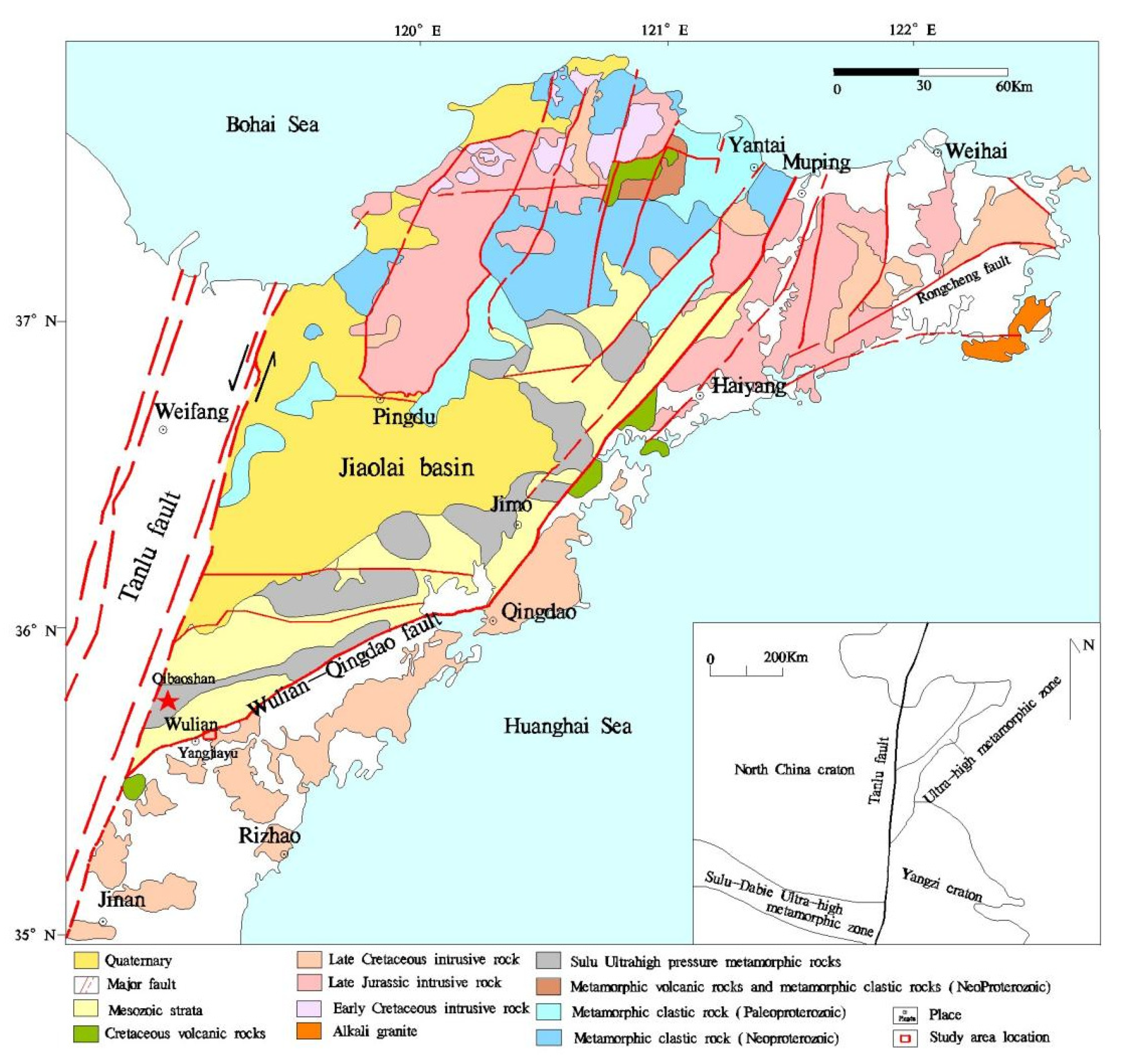
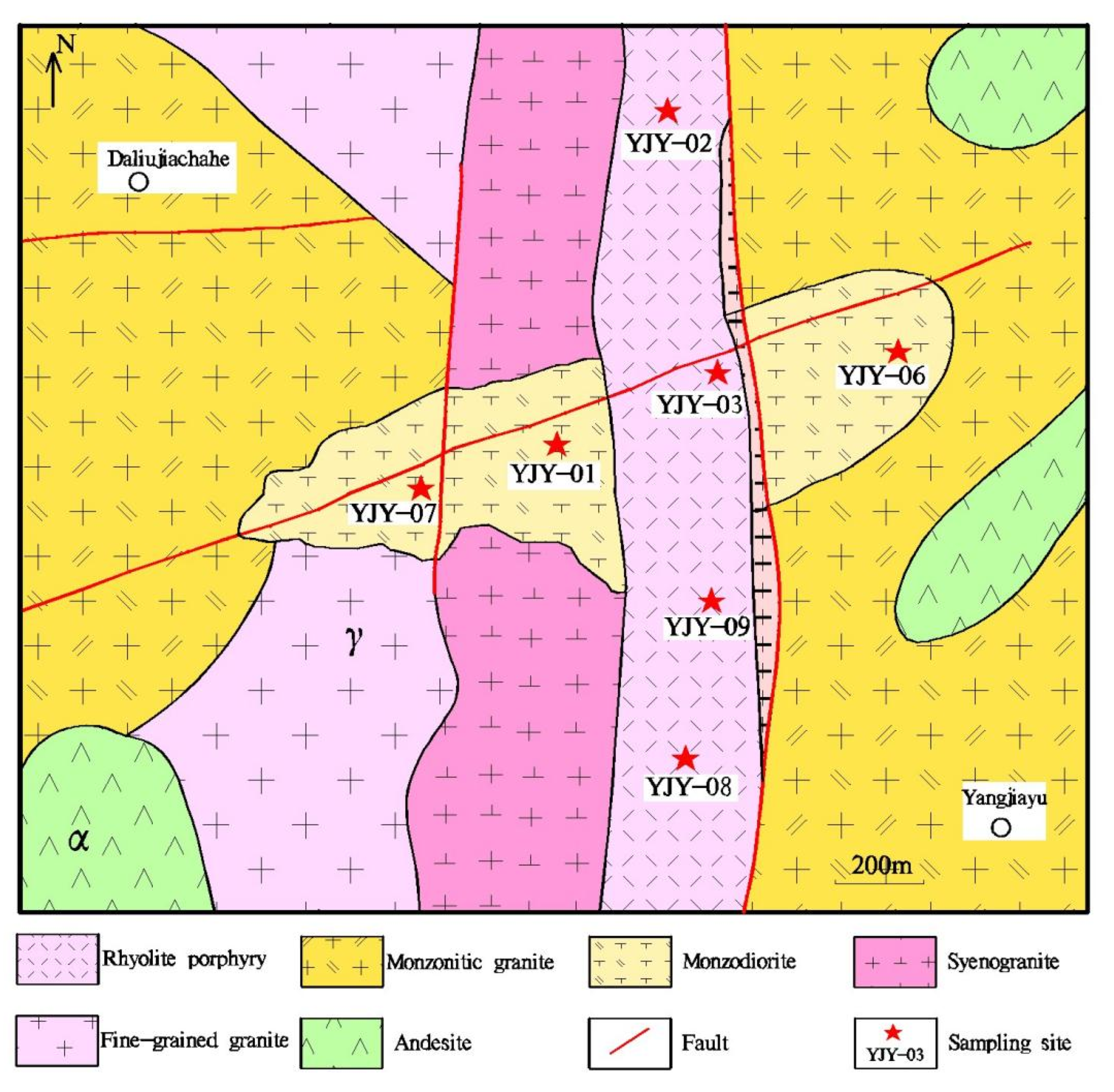
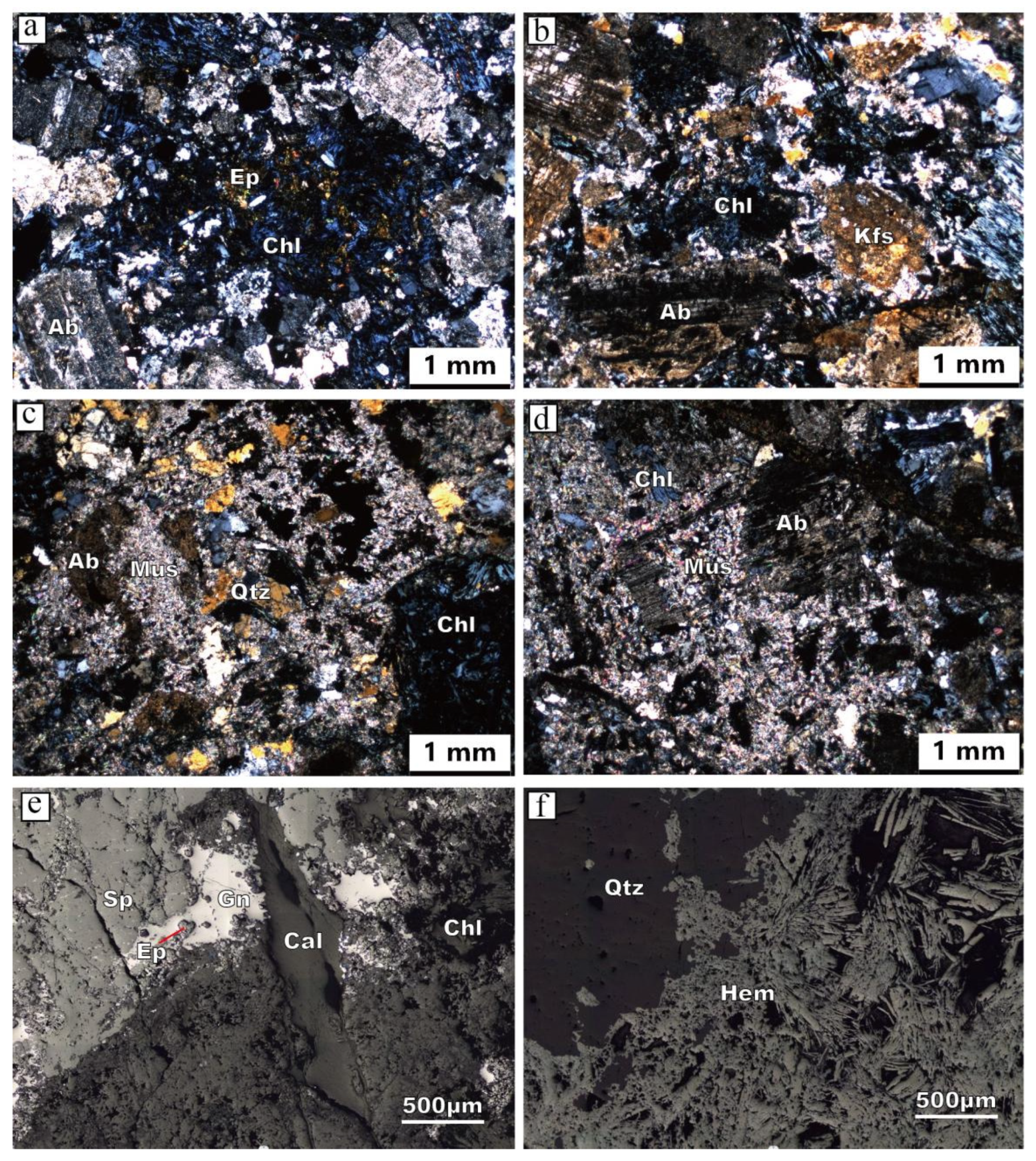

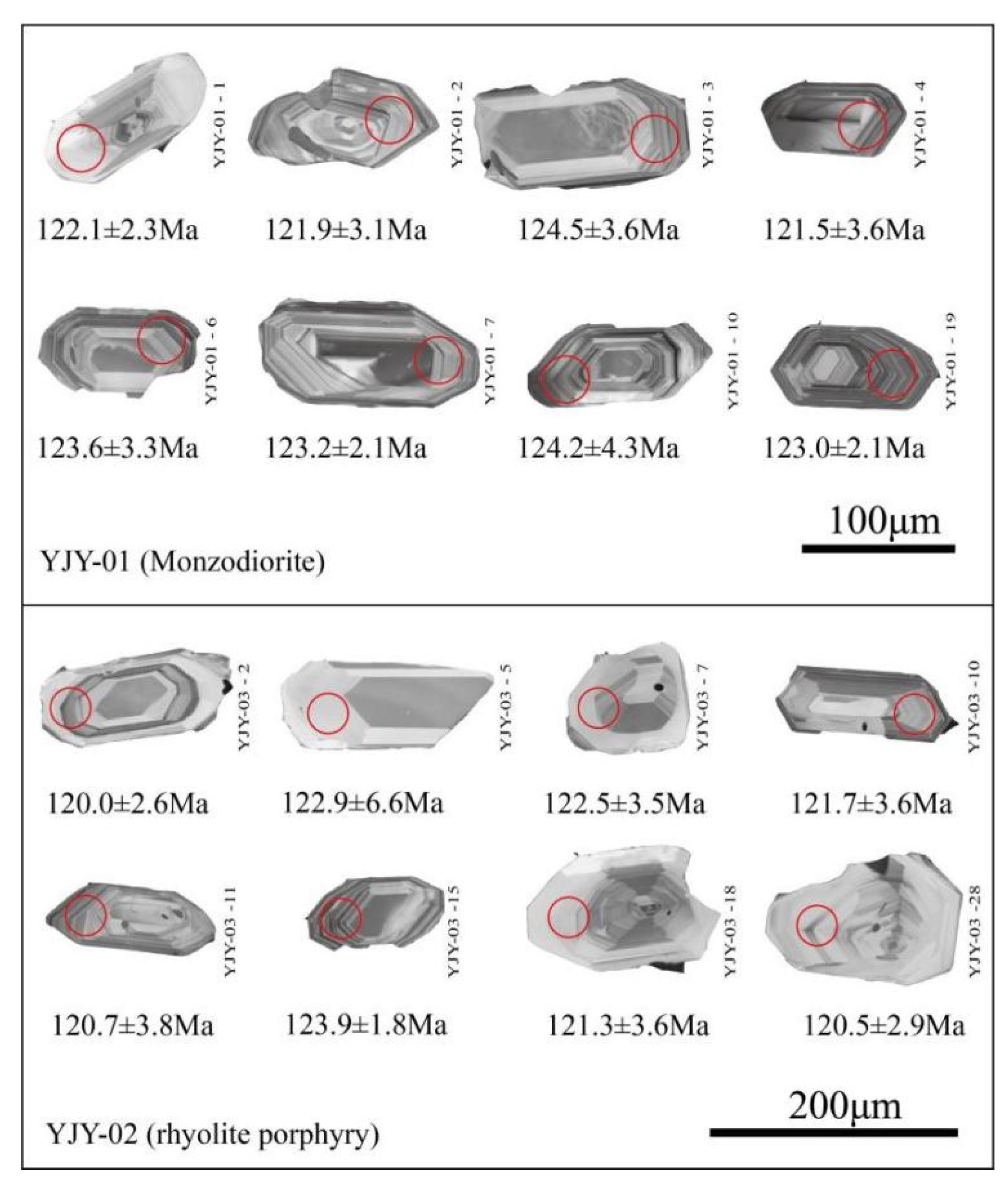
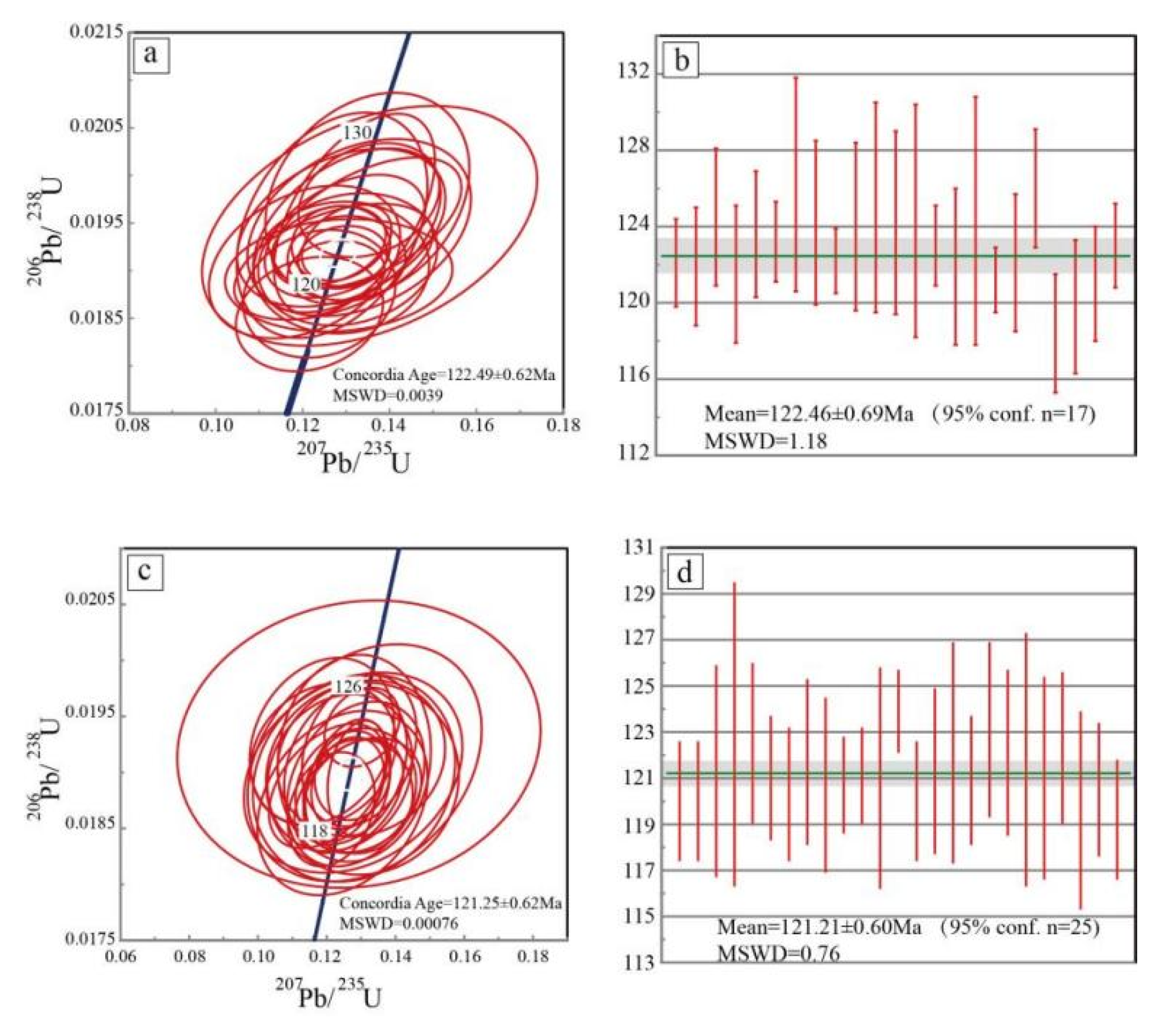
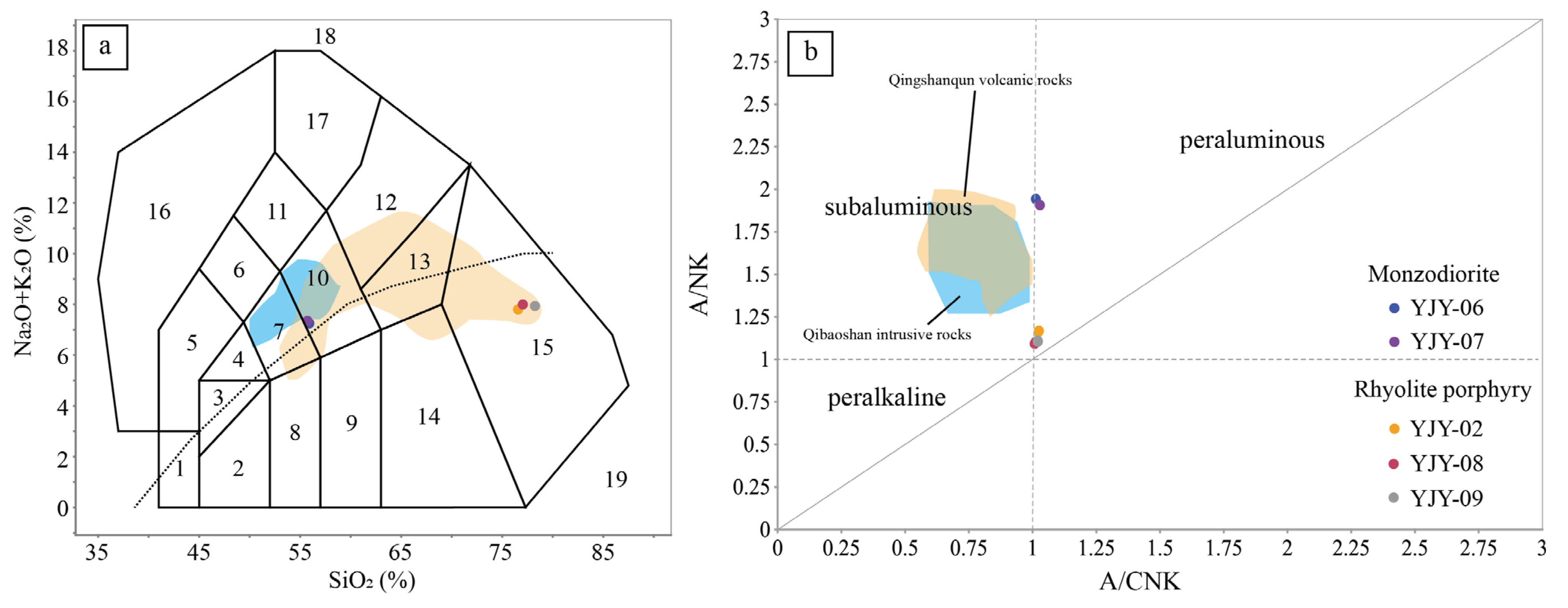
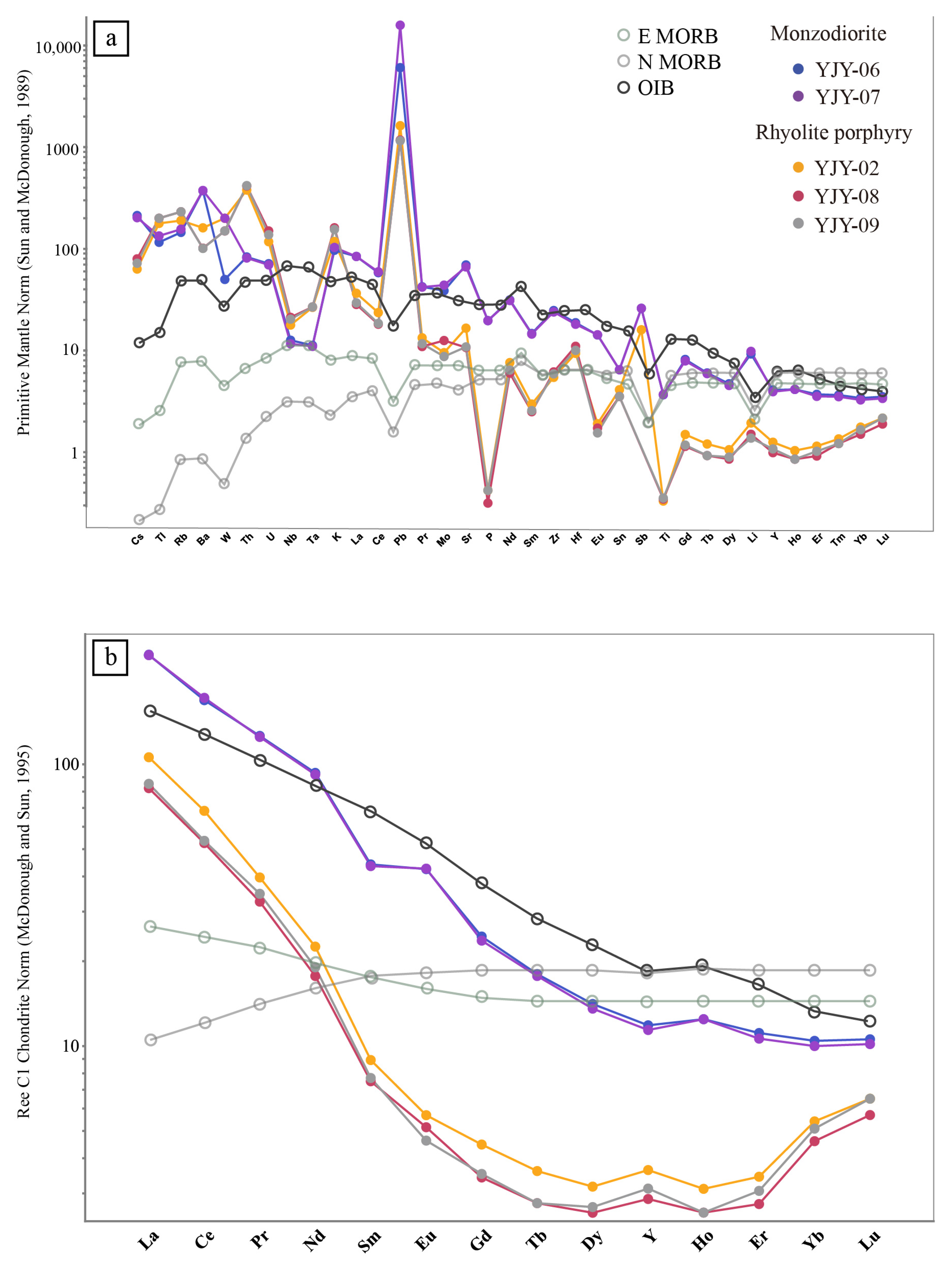

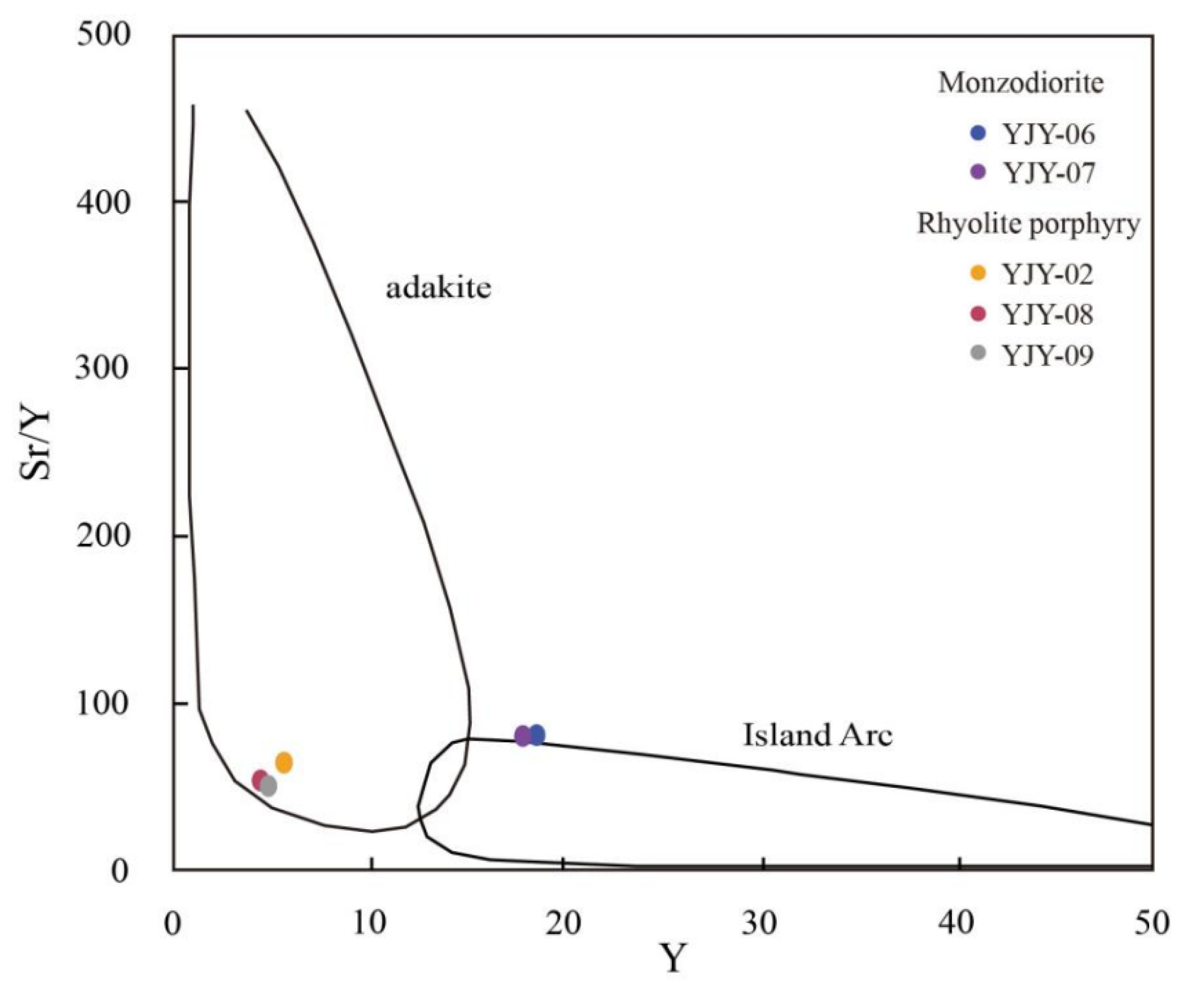
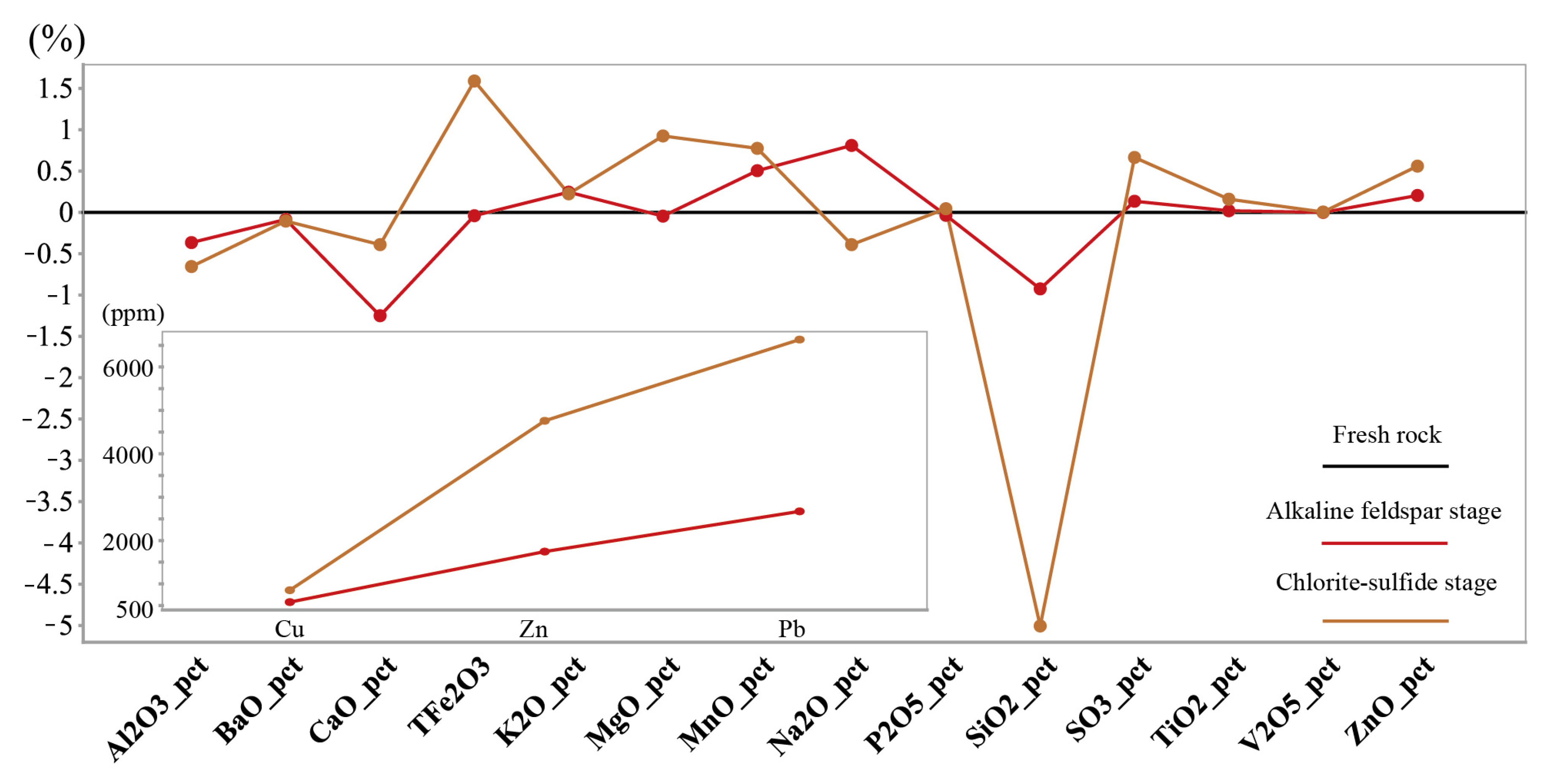
| Sample No. | (ppm) | Th/U | Isotopic Ratio | Isotopic Age | ||||||||||||||
|---|---|---|---|---|---|---|---|---|---|---|---|---|---|---|---|---|---|---|
| Th | U | 207Pb/206Pb | 2σ | rho | 207Pb/235U | 2σ | 206Pb/238U | 2σ | rho | 207Pb/206Pb | 2σ | 207Pb/235U | 2σ | 206Pb/238U | 2σ | Concordance | ||
| YJY-01-1 | 339 | 289 | 1.17 | 0.0493 | 0.0041 | 0.2074 | 0.1301 | 0.0111 | 0.0191 | 0.0004 | 0.0270 | 72.2 | 196.7 | 123.7 | 9.9 | 122.1 | 2.3 | 99 |
| YJY-01-2 | 419 | 269 | 1.56 | 0.0483 | 0.0075 | 0.3464 | 0.1270 | 0.0187 | 0.0190 | 0.0005 | 0.4748 | 22.4 | 413.1 | 121.2 | 16.9 | 121.9 | 3.1 | 99 |
| YJY-01-3 | 226 | 339 | 0.67 | 0.0507 | 0.0073 | 0.3385 | 0.1347 | 0.0178 | 0.0195 | 0.0006 | 0.5389 | 123.1 | 342.6 | 128.0 | 15.8 | 124.5 | 3.6 | 97 |
| YJY-01-4 | 146 | 84 | 1.74 | 0.0493 | 0.0062 | 0.2377 | 0.1289 | 0.0165 | 0.01903 | 0.0006 | 0.0431 | −31.5 | 338.8 | 121.3 | 14.8 | 121.5 | 3.6 | 100 |
| YJY-01-6 | 158 | 109 | 1.45 | 0.0477 | 0.0055 | 0.2007 | 0.1297 | 0.0151 | 0.0193 | 0.0005 | 0.4230 | −143.9 | 339.6 | 122.8 | 13.4 | 123.6 | 3.3 | 99 |
| YJY-01-7 | 286 | 178 | 1.61 | 0.0494 | 0.0034 | 0.0960 | 0.1301 | 0.0084 | 0.0192 | 0.0003 | 0.3541 | 4.3 | 169.4 | 123.3 | 7.6 | 123.2 | 2.1 | 100 |
| YJY-01-9 | 148 | 145 | 1.02 | 0.0483 | 0.0066 | 0.0871 | 0.1348 | 0.0192 | 0.0197 | 0.0009 | 0.2648 | −53.5 | 394.8 | 127.3 | 17 | 126.2 | 5.6 | 99 |
| YJY-01-10 | 53 | 41 | 1.28 | 0.0498 | 0.0078 | 0.1370 | 0.1288 | 0.0196 | 0.0194 | 0.0007 | 0.3700 | −192.7 | 417.6 | 122.4 | 18.3 | 124.2 | 4.3 | 99 |
| YJY-01-11 | 625 | 290 | 2.16 | 0.0491 | 0.0032 | 0.0920 | 0.1292 | 0.0084 | 0.0191 | 0.0003 | 0.1327 | −18.6 | 166.2 | 122.8 | 7.5 | 122.2 | 1.7 | 100 |
| YJY-01-15 | 231 | 165 | 1.40 | 0.0489 | 0.0071 | 0.2137 | 0.1301 | 0.0176 | 0.0194 | 0.0007 | 0.4561 | −19.4 | 392.5 | 123.8 | 15.7 | 124.0 | 4.4 | 100 |
| YJY-01-16 | 234 | 170 | 1.37 | 0.0475 | 0.0052 | 0.1816 | 0.1319 | 0.0151 | 0.0195 | 0.0009 | 0.5385 | 3.2 | 346.4 | 125.3 | 13.5 | 125.0 | 5.5 | 100 |
| YJY-01-17 | 321 | 132 | 2.44 | 0.0505 | 0.0084 | 0.1545 | 0.1330 | 0.0210 | 0.0194 | 0.0008 | 0.3289 | 143.0 | 340.2 | 125.4 | 18.7 | 124.2 | 4.8 | 99 |
| YJY-01-18 | 509 | 167 | 3.04 | 0.0479 | 0.0071 | 0.0069 | 0.1267 | 0.0179 | 0.0194 | 0.0010 | 0.3471 | 35.9 | 323.7 | 120.5 | 16.4 | 124.3 | 6.1 | 97 |
| YJY-01-19 | 210 | 137 | 1.54 | 0.0473 | 0.0041 | 0.0851 | 0.1260 | 0.0107 | 0.0192 | 0.0003 | 0.2708 | −232.1 | 255.3 | 119.1 | 9.6 | 123.0 | 2.1 | 97 |
| YJY-01-20 | 931 | 408 | 2.28 | 0.0456 | 0.0069 | 0.1330 | 0.1204 | 0.0180 | 0.0190 | 0.0007 | 0.3290 | −118.8 | 428.1 | 115.2 | 16.3 | 121.9 | 4.1 | 94 |
| YJY-01-21 | 103 | 84 | 1.22 | 0.0517 | 0.0122 | 0.1187 | 0.1354 | 0.0315 | 0.0194 | 0.0010 | 0.3846 | 209.1 | 579.4 | 126.9 | 28.3 | 124.3 | 6.5 | 98 |
| YJY-01-23 | 240 | 177 | 1.36 | 0.0485 | 0.0034 | 0.0865 | 0.1277 | 0.0091 | 0.0189 | 0.0003 | 0.1016 | −93.3 | 180.9 | 121.0 | 8.1 | 121.2 | 1.7 | 100 |
| YJY-01-24 | 70 | 41 | 1.71 | 0.0498 | 0.0066 | 0.0056 | 0.1303 | 0.0168 | 0.0191 | 0.0006 | 0.1688 | −167.6 | 338.1 | 122.7 | 15.4 | 122.1 | 3.6 | 100 |
| YJY-01-26 | 497 | 383 | 1.30 | 0.0498 | 0.0049 | 0.0198 | 0.1352 | 0.0132 | 0.0197 | 0.0005 | 0.2437 | 130.6 | 225.4 | 128.3 | 11.8 | 126.0 | 3.1 | 98 |
| YJY-01-27 | 78 | 69 | 1.14 | 0.0482 | 0.0056 | 0.0090 | 0.1215 | 0.0138 | 0.0185 | 0.0005 | 0.1938 | 142.5 | 220.4 | 114.2 | 12.4 | 118.4 | 3.1 | 96 |
| YJY-01-28 | 132 | 101 | 1.31 | 0.0482 | 0.0057 | 0.0496 | 0.1238 | 0.0143 | 0.0187 | 0.0005 | 0.1512 | −167.1 | 308.4 | 119.1 | 13.5 | 119.8 | 3.5 | 99 |
| YJY-01-29 | 209 | 154 | 1.36 | 0.0486 | 0.0081 | 0.2623 | 0.1283 | 0.0214 | 0.0189 | 0.0005 | 0.1113 | −15.3 | 432.9 | 121.3 | 19.5 | 121.0 | 3.0 | 100 |
| YJY-01-30 | 281 | 231 | 1.22 | 0.0484 | 0.0034 | 0.2204 | 0.1288 | 0.0093 | 0.01925 | 0.0003 | 0.0115 | −10.8 | 182.8 | 122.5 | 8.3 | 123.0 | 2.2 | 100 |
| YJY-03-2 | 402 | 270 | 1.49 | 0.0488 | 0.0049 | 0.2306 | 0.1290 | 0.0130 | 0.0187 | 0.0004 | 0.0508 | −5.9 | 262.5 | 122.8 | 11.7 | 120.0 | 2.6 | 98 |
| YJY-03-3 | 86 | 72 | 1.20 | 0.0505 | 0.0055 | 0.0025 | 0.1303 | 0.0140 | 0.0187 | 0.0004 | 0.2545 | 249.1 | 216.2 | 121.9 | 12.5 | 120.0 | 2.6 | 98 |
| YJY-03-4 | 157 | 100 | 1.57 | 0.0498 | 0.0105 | 0.1790 | 0.1277 | 0.0260 | 0.0189 | 0.0007 | 0.2577 | −217.2 | 541.5 | 119.5 | 22.9 | 121.3 | 4.6 | 99 |
| YJY-03-5 | 35 | 30 | 1.18 | 0.0478 | 0.0163 | 0.1306 | 0.1293 | 0.0432 | 0.0192 | 0.0010 | 0.0986 | 122.5 | 599 | 117.2 | 38.2 | 122.9 | 6.6 | 95 |
| YJY-03-7 | 74 | 61 | 1.21 | 0.0492 | 0.0053 | 0.0844 | 0.1294 | 0.0136 | 0.0191 | 0.0006 | 0.2546 | 182.5 | 227.1 | 121.2 | 12.2 | 122.5 | 3.5 | 99 |
| YJY-03-8 | 516 | 418 | 1.23 | 0.0488 | 0.0028 | 0.0886 | 0.1294 | 0.0075 | 0.0189 | 0.0004 | 0.2061 | 81.5 | 135.6 | 123.2 | 6.7 | 121.0 | 2.7 | 98 |
| YJY-03-9 | 74 | 65 | 1.15 | 0.0491 | 0.0055 | 0.0766 | 0.1284 | 0.0143 | 0.0188 | 0.0005 | 0.1324 | 302.3 | 213 | 120.1 | 12.8 | 120.3 | 2.9 | 100 |
| YJY-03-10 | 80 | 55 | 1.45 | 0.0491 | 0.0060 | 0.0494 | 0.1254 | 0.0146 | 0.0190 | 0.0006 | 0.2579 | −121.0 | 325.1 | 117.8 | 13 | 121.7 | 3.6 | 97 |
| YJY-03-11 | 152 | 89 | 1.70 | 0.0500 | 0.0067 | 0.0046 | 0.1284 | 0.0164 | 0.0188 | 0.0006 | 0.2792 | −286.7 | 379.8 | 121.0 | 14.5 | 120.7 | 3.8 | 100 |
| YJY-03-12 | 245 | 205 | 1.19 | 0.0488 | 0.0034 | 0.0117 | 0.1261 | 0.0087 | 0.0189 | 0.0003 | 0.2198 | −18.3 | 191.6 | 119.9 | 7.8 | 120.7 | 2.1 | 99 |
| YJY-03-13 | 161 | 158 | 1.02 | 0.0493 | 0.0035 | 0.0986 | 0.1274 | 0.0089 | 0.0189 | 0.0003 | 0.1013 | 42.3 | 176.6 | 120.8 | 8.1 | 121.1 | 2.1 | 100 |
| YJY-03-14 | 121 | 83 | 1.45 | 0.0482 | 0.0090 | 0.0489 | 0.1279 | 0.0240 | 0.0189 | 0.0008 | 0.1539 | −360.3 | 531.7 | 120.2 | 21.2 | 121.0 | 4.8 | 99 |
| YJY-03-15 | 434 | 319 | 1.36 | 0.0482 | 0.0034 | 0.0566 | 0.1302 | 0.0089 | 0.0194 | 0.0003 | 0.2580 | −1.1 | 184.8 | 123.9 | 8 | 123.9 | 1.8 | 100 |
| YJY-03-16 | 362 | 218 | 1.66 | 0.0492 | 0.0055 | 0.1925 | 0.1264 | 0.0129 | 0.0187 | 0.0004 | 0.4143 | −66.6 | 298.7 | 120.2 | 11.7 | 120.0 | 2.6 | 100 |
| YJY-03-18 | 78 | 67 | 1.17 | 0.0481 | 0.0070 | 0.0260 | 0.1238 | 0.0172 | 0.0189 | 0.0006 | 0.1728 | 107.5 | 270.8 | 115.9 | 15.5 | 121.3 | 3.6 | 95 |
| YJY-03-19 | 84 | 67 | 1.25 | 0.0508 | 0.0077 | 0.1072 | 0.1280 | 0.0182 | 0.0191 | 0.0008 | 0.0761 | −84.8 | 423.9 | 120.5 | 16.3 | 122.1 | 4.8 | 99 |
| YJY-03-20 | 686 | 286 | 2.40 | 0.0478 | 0.0042 | 0.1270 | 0.1256 | 0.0097 | 0.0189 | 0.0004 | 0.3871 | −16.5 | 206.8 | 119.9 | 8.8 | 120.9 | 2.8 | 99 |
| YJY-03-21 | 84 | 58 | 1.45 | 0.0443 | 0.0063 | 0.0288 | 0.1186 | 0.0172 | 0.0192 | 0.0006 | 0.2282 | 70.0 | 301.3 | 110.9 | 15.5 | 123.1 | 3.8 | 90 |
| YJY-03-23 | 112 | 96 | 1.16 | 0.0493 | 0.0074 | 0.0884 | 0.1300 | 0.0199 | 0.0191 | 0.0006 | 0.1330 | −235.4 | 401.7 | 121.9 | 17.5 | 122.1 | 3.6 | 100 |
| YJY-03-24 | 38 | 28 | 1.37 | 0.0485 | 0.0101 | 0.0459 | 0.1310 | 0.0278 | 0.0190 | 0.0009 | 0.2808 | 436.7 | 370.6 | 117.2 | 24.4 | 121.8 | 5.5 | 96 |
| YJY-03-25 | 83 | 60 | 1.38 | 0.0503 | 0.0089 | 0.1625 | 0.1304 | 0.0229 | 0.0189 | 0.0007 | 0.0364 | −108.9 | 513 | 120.6 | 20.3 | 121.0 | 4.4 | 100 |
| YJY-03-26 | 72 | 54 | 1.33 | 0.0456 | 0.0067 | 0.0158 | 0.1190 | 0.0172 | 0.0191 | 0.0005 | 0.1903 | −312.7 | 414.9 | 111.3 | 15.5 | 122.3 | 3.3 | 91 |
| YJY-03-27 | 37 | 31 | 1.18 | 0.0494 | 0.0083 | 0.0126 | 0.1246 | 0.0202 | 0.0187 | 0.0007 | 0.2748 | 117.7 | 314.8 | 114.0 | 18 | 119.6 | 4.3 | 95 |
| YJY-03-28 | 73 | 62 | 1.16 | 0.0459 | 0.0055 | 0.0789 | 0.1202 | 0.0139 | 0.0188 | 0.0005 | 0.4370 | 118.9 | 236 | 113.3 | 12.6 | 120.5 | 2.9 | 94 |
| YJY-03-29 | 137 | 103 | 1.33 | 0.0475 | 0.0041 | 0.0463 | 0.1213 | 0.0103 | 0.0186 | 0.0004 | 0.2393 | −222.5 | 241.8 | 114.9 | 9.3 | 119.2 | 2.6 | 96 |
| GJ-1-1 | 19 | 254 | 0.08 | 0.0610 | 0.0015 | 0.0824 | 0.8229 | 0.0194 | 0.0977 | 0.0007 | 0.2189 | 612.2 | 51.9 | 607.8 | 10.7 | 600.7 | 4.1 | 99 |
| GJ-1-2 | 18 | 246 | 0.07 | 0.0609 | 0.0012 | 0.1767 | 0.8237 | 0.0173 | 0.0985 | 0.0008 | 0.1933 | 621.3 | 44.4 | 611.3 | 9.6 | 605.5 | 4.4 | 99 |
| GJ-1-3 | 18 | 240 | 0.07 | 0.0608 | 0.0016 | 0.1303 | 0.8271 | 0.0210 | 0.0981 | 0.0008 | 0.1709 | 610.7 | 54.1 | 609.9 | 11.6 | 603.3 | 4.6 | 99 |
| GJ-1-4 | 18 | 248 | 0.07 | 0.0601 | 0.0014 | 0.0470 | 0.8128 | 0.0176 | 0.0983 | 0.0008 | 0.3097 | 590.6 | 49 | 602.5 | 9.9 | 604.3 | 4.7 | 100 |
| 610-3 | 456 | 460 | 0.99 | 0.9122 | 0.0049 | 0.8720 | 28.2679 | 0.2821 | 0.2238 | 0.0025 | 0.3995 | 4985.9 | 0 | 3426.9 | 9.7 | 1301.3 | 13.1 | 10 |
| 610-4 | 449 | 451 | 1.00 | 0.9118 | 0.0050 | 0.8771 | 28.5079 | 0.3098 | 0.2267 | 0.0027 | 0.3779 | 4980.0 | 13 | 3434.9 | 10.6 | 1316.7 | 14.1 | 11 |
| 610-5 | 461 | 463 | 1.00 | 0.9079 | 0.0048 | 0.8479 | 28.2774 | 0.2922 | 0.2251 | 0.0024 | 0.2711 | 4979.3 | 29.6 | 3427.1 | 10.1 | 1308.3 | 12.5 | 11 |
| 91500-1 | 27 | 80 | 0.34 | 0.0757 | 0.0021 | 0.0619 | 1.8657 | 0.0495 | 0.1786 | 0.0015 | 0.2600 | 1060.6 | 57.3 | 1066.4 | 18.1 | 1059.0 | 8.2 | 99 |
| 91500-2 | 27 | 80 | 0.34 | 0.0747 | 0.0020 | 0.0078 | 1.8467 | 0.0453 | 0.1800 | 0.0016 | 0.3457 | 1043.5 | 52.4 | 1058.0 | 16.4 | 1066.9 | 8.8 | 99 |
| 91500-3 | 27 | 80 | 0.34 | 0.0769 | 0.0021 | 0.0885 | 1.9001 | 0.0518 | 0.1789 | 0.0018 | 0.2678 | 1092.6 | 57.5 | 1075.9 | 18.2 | 1060.7 | 10.0 | 99 |
| 91500-4 | 28 | 81 | 0.34 | 0.0735 | 0.0019 | 0.2677 | 1.8153 | 0.0467 | 0.1790 | 0.0017 | 0.1476 | 1007.8 | 50.9 | 1048.7 | 16.5 | 1061.1 | 9.4 | 99 |
| 91500-5 | 27 | 79 | 0.34 | 0.0735 | 0.0021 | 0.0148 | 1.8201 | 0.0477 | 0.1790 | 0.0017 | 0.3325 | 994.8 | 56.7 | 1048.0 | 17.1 | 1061.5 | 9.3 | 99 |
| 91500-6 | 27 | 80 | 0.34 | 0.0748 | 0.0019 | 0.1827 | 1.8653 | 0.0478 | 0.1799 | 0.0016 | 0.1772 | 1041.0 | 53.3 | 1066.5 | 17.3 | 1066.0 | 9.0 | 100 |
| 91500-7 | 27 | 79 | 0.34 | 0.0748 | 0.0018 | 0.2578 | 1.8461 | 0.0467 | 0.1789 | 0.0016 | 0.0784 | 1043.9 | 51.8 | 1059.8 | 17.2 | 1061.0 | 8.9 | 100 |
| 91500-8 | 27 | 80 | 0.34 | 0.0750 | 0.0021 | 0.0519 | 1.8323 | 0.0468 | 0.1788 | 0.0017 | 0.3635 | 1034.4 | 58.7 | 1054.7 | 17.6 | 1060.3 | 9.5 | 99 |
| GJ-1-1 | 18 | 245 | 0.07 | 0.0603 | 0.0013 | 0.2044 | 0.8082 | 0.0182 | 0.0970 | 0.0008 | 0.1516 | 596.9 | 48 | 599.8 | 10.3 | 596.5 | 4.5 | 99 |
| GJ-1-2 | 17 | 237 | 0.07 | 0.0607 | 0.0015 | 0.0335 | 0.8198 | 0.0195 | 0.0977 | 0.0007 | 0.2875 | 599.2 | 55.5 | 606.1 | 10.9 | 600.9 | 4.4 | 99 |
| GJ-1-3 | 17 | 239 | 0.07 | 0.0606 | 0.0014 | 0.1206 | 0.8168 | 0.0182 | 0.0979 | 0.0007 | 0.1908 | 599.8 | 50 | 606.0 | 10.4 | 601.8 | 4.2 | 99 |
| GJ-1-4 | 17 | 238 | 0.07 | 0.0608 | 0.0022 | 0.0648 | 0.8229 | 0.0272 | 0.0987 | 0.0011 | 0.3736 | 610.0 | 76.3 | 608.3 | 15.1 | 606.8 | 6.6 | 100 |
| 610-1 | 457 | 461 | 0.99 | 0.9138 | 0.0045 | 0.8976 | 28.0235 | 0.3269 | 0.2220 | 0.0024 | 0.2194 | 4996.5 | 0 | 3417.9 | 11.3 | 1292.1 | 12.6 | 10 |
| 610-3 | 458 | 461 | 0.99 | 0.9125 | 0.0049 | 0.8717 | 27.8404 | 0.2935 | 0.2208 | 0.0024 | 0.4647 | 4993.3 | 10.7 | 3411.8 | 10.2 | 1285.9 | 12.9 | 9 |
| 610-4 | 457 | 461 | 0.99 | 0.9147 | 0.0052 | 0.8676 | 28.0273 | 0.3347 | 0.2216 | 0.0024 | 0.2100 | 4989.9 | 0 | 3417.9 | 11.5 | 1290.1 | 12.7 | 10 |
| 91500-1 | 29 | 81 | 0.36 | 0.0749 | 0.0021 | 0.1097 | 1.8434 | 0.0493 | 0.1783 | 0.0017 | 0.2550 | 1050.3 | 53.6 | 1058.4 | 17.2 | 1057.5 | 9.5 | 100 |
| 91500-2 | 30 | 82 | 0.36 | 0.0747 | 0.0020 | 0.0730 | 1.8522 | 0.0476 | 0.1797 | 0.0017 | 0.2532 | 1044.8 | 53.9 | 1064.4 | 16.9 | 1065.2 | 9.3 | 100 |
| 91500-3 | 29 | 80 | 0.36 | 0.0746 | 0.0024 | 0.0627 | 1.8425 | 0.0576 | 0.1781 | 0.0018 | 0.2687 | 1039.6 | 62.3 | 1056.7 | 20.1 | 1056.5 | 9.8 | 100 |
| 91500-4 | 29 | 80 | 0.36 | 0.0754 | 0.0019 | 0.0247 | 1.8796 | 0.0440 | 0.1808 | 0.0017 | 0.3682 | 1051.0 | 52.9 | 1070.0 | 15.7 | 1071.0 | 9.3 | 100 |
| 91500-5 | 29 | 80 | 0.36 | 0.0738 | 0.0020 | 0.2968 | 1.8019 | 0.0463 | 0.1780 | 0.0017 | 0.0614 | 1006.2 | 54.3 | 1043.8 | 17.4 | 1055.8 | 9.2 | 99 |
| 91500-6 | 29 | 81 | 0.36 | 0.0749 | 0.0020 | 0.0475 | 1.8600 | 0.0455 | 0.1799 | 0.0015 | 0.3477 | 1036.0 | 55.2 | 1062.7 | 16.5 | 1066.3 | 8.0 | 100 |
| 91500-7 | 29 | 81 | 0.36 | 0.0755 | 0.0021 | 0.0299 | 1.8722 | 0.0487 | 0.1797 | 0.0018 | 0.3295 | 1057.1 | 56.6 | 1066.5 | 17.5 | 1065.3 | 9.8 | 100 |
| 91500-8 | 29 | 81 | 0.36 | 0.0747 | 0.0020 | 0.1403 | 1.8465 | 0.0498 | 0.1786 | 0.0016 | 0.2158 | 1030.6 | 55.3 | 1057.2 | 17.6 | 1059.1 | 8.8 | 100 |
| Sample No. | SiO2 | TiO2 | Al2O3 | TFe2O3 | FeO | MnO | MgO | CaO | Na2O | K2O | P2O5 | |
|---|---|---|---|---|---|---|---|---|---|---|---|---|
| YJY-02 | Rhyolite Porphyry | 76.57 | 0.06 | 12.33 | 0.96 | 0.26 | 0.03 | 0.13 | 0.77 | 4.12 | 3.68 | 0.01 |
| YJY-08 | 77.04 | 0.07 | 12.00 | 1.19 | 0.36 | 0.01 | 0.07 | 0.56 | 3.30 | 4.70 | 0.01 | |
| YJY-09 | 78.24 | 0.06 | 11.99 | 1.07 | 0.34 | 0.01 | 0.10 | 0.51 | 3.31 | 4.63 | 0.01 | |
| YJY-06 | Monzodiorite | 55.87 | 0.76 | 19.45 | 5.74 | 2.88 | 0.16 | 2.29 | 4.93 | 4.33 | 2.93 | 0.39 |
| YJY-07 | 55.78 | 0.76 | 19.36 | 5.86 | 2.95 | 0.23 | 2.30 | 4.73 | 4.21 | 3.10 | 0.40 | |
| YJY-01 | Chloritized intrusion | 51.09 | 0.99 | 17.94 | 7.93 | 4.66 | 1.00 | 3.96 | 4.87 | 3.69 | 2.29 | 0.46 |
| YJY-05 | 50.55 | 0.85 | 19.56 | 6.85 | 4.17 | 0.94 | 2.48 | 4.01 | 4.07 | 4.19 | 0.42 | |
| YJY-04 | Alkali-feldspathized intrusion | 54.90 | 0.78 | 19.04 | 5.76 | 3.19 | 0.70 | 2.25 | 3.58 | 5.08 | 3.26 | 0.36 |
| Sample No. | LOI | Total | Na2O + K2O | K2O/Na2O | A/CNK | A/NK | La | Ce | Pr | Nd | Sm | |
| YJY-02 | Rhyolite Porphyry | 0.68 | 99.6 | 7.8 | 0.89 | 1.44 | 1.58 | 25.1 | 41.9 | 3.68 | 10.3 | 1.32 |
| YJY-08 | 0.32 | 99.63 | 8 | 1.42 | 1.40 | 2.68 | 19.5 | 32.2 | 3.02 | 8.1 | 1.11 | |
| YJY-09 | 0.38 | 100.65 | 7.94 | 1.40 | 1.42 | 2.65 | 20.2 | 32.8 | 3.22 | 8.7 | 1.14 | |
| YJY-06 | Monzodiorite | 2.58 | 102.31 | 7.26 | 0.68 | 1.60 | 1.50 | 57.9 | 103.5 | 11.70 | 42.6 | 6.53 |
| YJY-07 | 2.51 | 102.19 | 7.31 | 0.74 | 1.61 | 1.51 | 57.8 | 105.5 | 11.60 | 42.0 | 6.44 | |
| YJY-01 | Chloritized intrusion | 3.47 | 102.35 | 5.98 | 0.62 | 1.65 | 3.00 | 57.20 | 113.00 | 12.85 | 49.10 | 8.19 |
| YJY-05 | 3.88 | 101.97 | 8.26 | 1.03 | 1.59 | 2.37 | 58.60 | 109.50 | 11.75 | 42.60 | 6.92 | |
| YJY-04 | Alkali-feldspathized intrusion | 2.47 | 101.37 | 8.34 | 0.64 | 1.60 | 2.28 | 57.40 | 107.50 | 11.45 | 41.60 | 6.74 |
| Sample No. | Eu | Gd | Tb | Dy | Ho | Er | Tm | Yb | Lu | Y | Li | |
| YJY-02 | Rhyolite Porphyry | 0.32 | 0.89 | 0.13 | 0.78 | 0.17 | 0.55 | 0.10 | 0.87 | 0.16 | 5.7 | 3.1 |
| YJY-08 | 0.29 | 0.68 | 0.10 | 0.63 | 0.14 | 0.44 | 0.09 | 0.74 | 0.14 | 4.5 | 2.4 | |
| YJY-09 | 0.26 | 0.70 | 0.10 | 0.66 | 0.14 | 0.49 | 0.09 | 0.82 | 0.16 | 4.9 | 2.2 | |
| YJY-06 | Monzodiorite | 2.39 | 4.87 | 0.65 | 3.47 | 0.68 | 1.78 | 0.27 | 1.68 | 0.26 | 18.6 | 14.8 |
| YJY-07 | 2.40 | 4.71 | 0.64 | 3.34 | 0.68 | 1.70 | 0.26 | 1.61 | 0.25 | 17.9 | 15.7 | |
| YJY-01 | Chloritized intrusion | 2.44 | 33.60 | 0.84 | 4.48 | 0.87 | 2.21 | 0.32 | 1.94 | 0.30 | 22.70 | 24.80 |
| YJY-05 | 2.23 | 31.10 | 0.62 | 3.49 | 0.66 | 1.70 | 0.26 | 1.76 | 0.26 | 18.00 | 15.10 | |
| YJY-04 | Alkali-feldspathized intrusion | 2.19 | 12.85 | 0.62 | 3.35 | 0.66 | 1.67 | 0.25 | 1.67 | 0.27 | 17.80 | 14.20 |
| Sample No. | Be | Sc | Cr | V | Co | Ni | Cu | Pb | Zn | Sn | Ga | |
| YJY-02 | Rhyolite Porphyry | 2.52 | 0.9 | 8 | 19 | 1.5 | 2.5 | 39.6 | 115.5 | 87 | 0.7 | 14.4 |
| YJY-08 | 2.81 | 0.8 | 11 | 7 | 1.3 | 3.9 | 17.0 | 83.4 | 65 | 0.6 | 14.5 | |
| YJY-09 | 2.87 | 0.9 | 9 | 7 | 1.2 | 3.7 | 16.9 | 82.1 | 56 | 0.6 | 14.9 | |
| YJY-06 | Monzodiorite | 1.76 | 7.9 | 18 | 101 | 14.0 | 8.9 | 45.3 | 430 | 530 | 1.1 | 21.8 |
| YJY-07 | 1.75 | 8.1 | 15 | 102 | 13.4 | 8.4 | 73.5 | 1125 | 1100 | 1.1 | 20.2 | |
| YJY-01 | Chloritized intrusion | 1.89 | 17.20 | 24.00 | 152.00 | 19.80 | 24.90 | 688.00 | 6650.00 | 5330.00 | 1.50 | 3.29 |
| YJY-05 | 2.35 | 7.40 | 9.00 | 102.00 | 14.00 | 7.40 | 1140.00 | 8170.00 | 5820.00 | 2.30 | 2.76 | |
| YJY-04 | Alkali-feldspathized intrusion | 2.40 | 7.50 | 11.00 | 95.00 | 11.60 | 9.10 | 640.00 | 3450.00 | 2560.00 | 2.30 | 2.47 |
| Sample No. | Rb | Sr | Zr | Nb | Cs | Ba | Hf | Ta | Tl | Th | U | |
| YJY-02 | Rhyolite Porphyry | 120.5 | 350 | 61 | 12.7 | 0.50 | 1125 | 2.9 | 1.09 | 0.89 | 32.2 | 2.47 |
| YJY-08 | 147.0 | 226 | 69 | 15.1 | 0.63 | 710 | 3.4 | 1.10 | 1.00 | 35.3 | 3.15 | |
| YJY-09 | 147.0 | 229 | 66 | 14.5 | 0.57 | 706 | 3.1 | 1.10 | 1.00 | 35.6 | 2.89 | |
| YJY-06 | Monzodiorite | 92.2 | 1465 | 277 | 9.0 | 1.68 | 2610 | 5.8 | 0.46 | 0.58 | 7.07 | 1.50 |
| YJY-07 | 99.1 | 1400 | 268 | 8.3 | 1.60 | 2620 | 5.6 | 0.45 | 0.67 | 6.91 | 1.46 | |
| YJY-01 | Chloritized intrusion | 94.20 | 1165.00 | 260.00 | 10.50 | 1.26 | 1460.00 | 6.00 | 0.52 | 0.55 | 7.05 | 1.56 |
| YJY-05 | 205.00 | 731.00 | 240.00 | 11.00 | 1.59 | 2030.00 | 5.20 | 0.50 | 1.38 | 7.12 | 1.80 | |
| YJY-04 | Alkali-feldspathized intrusion | 156.00 | 961.00 | 361.00 | 10.00 | 1.22 | 1855.00 | 7.30 | 0.44 | 1.04 | 6.58 | 1.41 |
| Sample No. | ∑REE | ∑LREE | ∑HREE | ∑LR/∑HR | (La/Yb)N | (La/Sm)N | Rb/Sr | δCe | δEu | δ | ||
| YJY-02 | Rhyolite Porphyry | 92.87 | 82.62 | 10.25 | 8.06 | 11.96 | 19.45 | 0.34 | 1.07 | 0.90 | 1.81 | |
| YJY-08 | 72.48 | 64.22 | 8.26 | 7.77 | 11.05 | 17.77 | 0.65 | 1.06 | 1.02 | 1.88 | ||
| YJY-09 | 75.28 | 66.32 | 8.96 | 7.40 | 11.15 | 16.61 | 0.64 | 1.03 | 0.89 | 1.79 | ||
| YJY-06 | Monzodiorite | 264.78 | 224.62 | 40.16 | 5.59 | 5.58 | 23.24 | 0.16 | 0.95 | 1.30 | 4.10 | |
| YJY-07 | 264.93 | 225.74 | 39.19 | 5.76 | 5.65 | 24.20 | 0.28 | 0.97 | 1.33 | 4.18 | ||
| YJY-01 | Chloritized intrusion | 284.45 | 227.28 | 57.17 | 3.98 | 4.39 | 19.88 | 0.06 | 0.99 | 1.04 | 4.42 | 284.45 |
| YJY-05 | 259.09 | 220.10 | 38.99 | 5.65 | 5.33 | 22.45 | 0.28 | 0.99 | 1.18 | 9.04 | 259.09 | |
| YJY-04 | Alkali-feldspathized intrusion | 236.70 | 198.13 | 38.57 | 5.14 | 5.36 | 23.17 | 0.07 | 1.00 | 1.18 | 5.85 | 236.70 |
| Simple No. | (Ma) | 176Lu/177Hf | 2SE | 176Yb/177Hf | 2SE | 176Hf/177Hf | 2SE | εHf(t) | T1DM (Ma) | T2DM (Ma) |
|---|---|---|---|---|---|---|---|---|---|---|
| YJY1-1 | 122.1 | 0.001368 | 0.000014 | 0.042069 | 0.042069 | 0.281974 | 0.000023 | −25.7 | 1815 | 2777 |
| YJY1-2 | 121.9 | 0.001724 | 0.000032 | 0.049801 | 0.049801 | 0.282011 | 0.000031 | −24.4 | 1780 | 2698 |
| YJY1-3 | 124.5 | 0.001151 | 0.000007 | 0.031717 | 0.031717 | 0.282035 | 0.000026 | −23.4 | 1719 | 2641 |
| YJY1-4 | 121.5 | 0.000671 | 0.000008 | 0.020130 | 0.020130 | 0.282049 | 0.000028 | −23.0 | 1679 | 2610 |
| YJY1-5 | 123.6 | 0.000936 | 0.000005 | 0.028776 | 0.028776 | 0.282045 | 0.000041 | −23.1 | 1695 | 2618 |
| YJY1-6 | 123.2 | 0.001351 | 0.000011 | 0.042814 | 0.042814 | 0.281971 | 0.000026 | −25.8 | 1818 | 2783 |
| YJY1-7 | 126.2 | 0.001261 | 0.000006 | 0.035978 | 0.035978 | 0.281958 | 0.000025 | −26.1 | 1832 | 2809 |
| YJY1-8 | 124.2 | 0.001088 | 0.000005 | 0.033731 | 0.033731 | 0.282023 | 0.000032 | −23.9 | 1734 | 2668 |
| YJY1-9 | 122.2 | 0.001196 | 0.000003 | 0.037130 | 0.037130 | 0.282026 | 0.000021 | −23.8 | 1734 | 2663 |
| YJY1-10 | 124.0 | 0.001288 | 0.000011 | 0.037205 | 0.037205 | 0.282000 | 0.000020 | −24.7 | 1774 | 2718 |
| YJY1-11 | 125.0 | 0.001227 | 0.000012 | 0.039344 | 0.039344 | 0.281972 | 0.000022 | −25.7 | 1811 | 2779 |
| YJY1-12 | 124.2 | 0.001612 | 0.000023 | 0.051080 | 0.051080 | 0.281985 | 0.000023 | −25.3 | 1811 | 2753 |
| YJY1-13 | 124.3 | 0.000800 | 0.000009 | 0.024981 | 0.024981 | 0.282017 | 0.000025 | −24.0 | 1728 | 2679 |
| YJY1-14 | 123.0 | 0.001097 | 0.000003 | 0.035315 | 0.035315 | 0.282005 | 0.000025 | −24.5 | 1759 | 2707 |
| YJY1-15 | 121.9 | 0.001311 | 0.000015 | 0.042493 | 0.042493 | 0.281993 | 0.000021 | −25.0 | 1785 | 2735 |
| YJY3-1 | 120.0 | 0.001168 | 0.000002 | 0.033750 | 0.033750 | 0.281997 | 0.000022 | −24.9 | 1773 | 2726 |
| YJY3-2 | 120.0 | 0.000475 | 0.000002 | 0.014631 | 0.014631 | 0.282037 | 0.000022 | −23.4 | 1686 | 2636 |
| YJY3-3 | 121.3 | 0.000973 | 0.000038 | 0.031194 | 0.031194 | 0.282022 | 0.000023 | −24.0 | 1729 | 2671 |
| YJY3-4 | 122.9 | 0.001039 | 0.000014 | 0.033097 | 0.033097 | 0.282035 | 0.000024 | −23.5 | 1715 | 2642 |
| YJY3-5 | 122.5 | 0.000747 | 0.000002 | 0.023725 | 0.023725 | 0.282028 | 0.000024 | −23.7 | 1711 | 2655 |
| YJY3-6 | 121.0 | 0.001229 | 0.000017 | 0.038814 | 0.038814 | 0.281994 | 0.000026 | −25.0 | 1781 | 2734 |
| YJY3-7 | 120.3 | 0.000757 | 0.000001 | 0.022580 | 0.022580 | 0.282008 | 0.000022 | −24.4 | 1739 | 2700 |
| YJY3-8 | 121.7 | 0.001336 | 0.000039 | 0.043176 | 0.043176 | 0.282027 | 0.000025 | −23.8 | 1739 | 2661 |
| YJY3-9 | 120.7 | 0.000982 | 0.000005 | 0.031370 | 0.031370 | 0.282045 | 0.000023 | −23.2 | 1698 | 2622 |
| YJY3-10 | 120.7 | 0.001366 | 0.000021 | 0.043207 | 0.043207 | 0.282005 | 0.000023 | −24.6 | 1771 | 2710 |
| YJY3-11 | 121.1 | 0.001497 | 0.000004 | 0.045147 | 0.045147 | 0.281998 | 0.000027 | −24.8 | 1787 | 2725 |
| YJY3-12 | 121.0 | 0.001118 | 0.000038 | 0.036679 | 0.036679 | 0.282009 | 0.000022 | −24.4 | 1754 | 2699 |
| YJY3-13 | 123.9 | 0.001402 | 0.000008 | 0.037869 | 0.037869 | 0.282011 | 0.000021 | −24.3 | 1764 | 2694 |
| YJY3-14 | 120.0 | 0.001356 | 0.000002 | 0.043836 | 0.043836 | 0.282046 | 0.000027 | −23.2 | 1714 | 2621 |
| YJY3-15 | 121.3 | 0.000971 | 0.000006 | 0.030320 | 0.030320 | 0.282028 | 0.000021 | −23.7 | 1721 | 2657 |
| Sample No. | Cu | Pb | Zn | Al2O3 | BaO | CaO | TFe2O3 | K2O | Na2O |
|---|---|---|---|---|---|---|---|---|---|
| Alkali-feldspathized intrusion | 580.60 | 2672.50 | 1745.00 | −0.37 | −0.09 | −1.25 | −0.04 | 0.25 | 0.81 |
| Chloritized intrusion | 854.60 | 6632.50 | 4760.00 | −0.66 | −0.11 | −0.39 | 1.59 | 0.23 | −0.39 |
| Sample No. | MgO | MnO | P2O5 | SiO2 | SO3 | TiO2 | V2O5 | ZnO | |
| Alkali-feldspathized intrusion | −0.04 | 0.51 | −0.04 | −0.93 | 0.14 | 0.02 | 0.00 | 0.21 | |
| Chloritized intrusion | 0.93 | 0.78 | 0.05 | −5.01 | 0.67 | 0.16 | 0.01 | 0.56 |
Disclaimer/Publisher’s Note: The statements, opinions and data contained in all publications are solely those of the individual author(s) and contributor(s) and not of MDPI and/or the editor(s). MDPI and/or the editor(s) disclaim responsibility for any injury to people or property resulting from any ideas, methods, instructions or products referred to in the content. |
© 2025 by the authors. Licensee MDPI, Basel, Switzerland. This article is an open access article distributed under the terms and conditions of the Creative Commons Attribution (CC BY) license (https://creativecommons.org/licenses/by/4.0/).
Share and Cite
Zhao, H.; Han, Y.; Liu, Y.; Mao, G.; Chen, L.; Cui, Y.; Liu, Y.; Liu, Y.; Jiang, Q.; Wang, L. Chronology and Petrogenesis of the Yangjiayu Complex from Eastern China: Evidence from Zircon U–Pb Dating, Hf Isotopes, and Geochemical Characteristics. Minerals 2025, 15, 321. https://doi.org/10.3390/min15030321
Zhao H, Han Y, Liu Y, Mao G, Chen L, Cui Y, Liu Y, Liu Y, Jiang Q, Wang L. Chronology and Petrogenesis of the Yangjiayu Complex from Eastern China: Evidence from Zircon U–Pb Dating, Hf Isotopes, and Geochemical Characteristics. Minerals. 2025; 15(3):321. https://doi.org/10.3390/min15030321
Chicago/Turabian StyleZhao, Huiji, Yanchao Han, Yinan Liu, Guangzhou Mao, Lei Chen, Yuanyuan Cui, Yang Liu, Yongming Liu, Quanguo Jiang, and Lili Wang. 2025. "Chronology and Petrogenesis of the Yangjiayu Complex from Eastern China: Evidence from Zircon U–Pb Dating, Hf Isotopes, and Geochemical Characteristics" Minerals 15, no. 3: 321. https://doi.org/10.3390/min15030321
APA StyleZhao, H., Han, Y., Liu, Y., Mao, G., Chen, L., Cui, Y., Liu, Y., Liu, Y., Jiang, Q., & Wang, L. (2025). Chronology and Petrogenesis of the Yangjiayu Complex from Eastern China: Evidence from Zircon U–Pb Dating, Hf Isotopes, and Geochemical Characteristics. Minerals, 15(3), 321. https://doi.org/10.3390/min15030321




